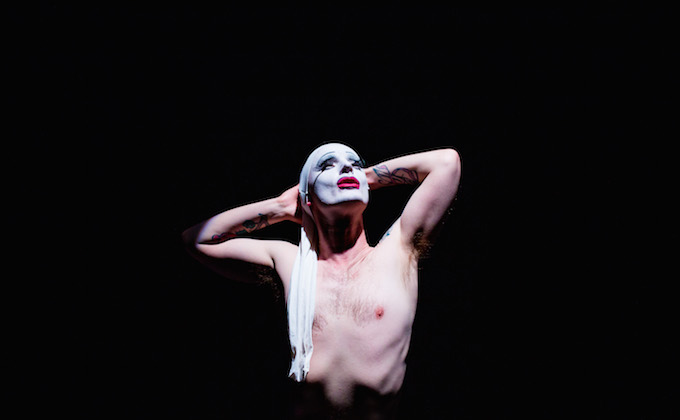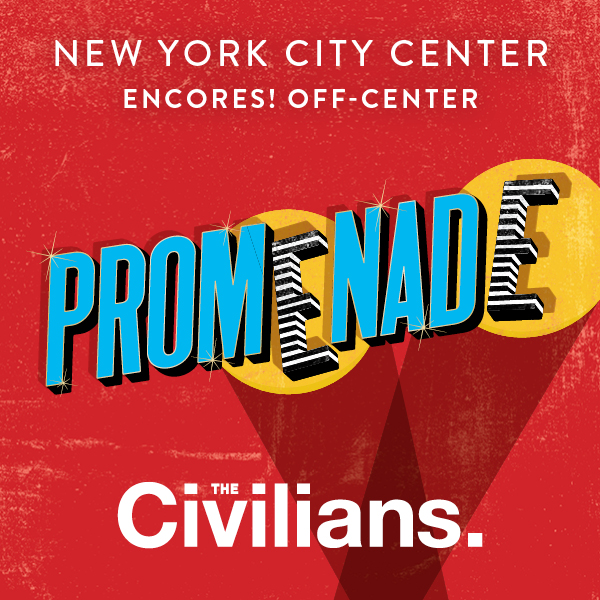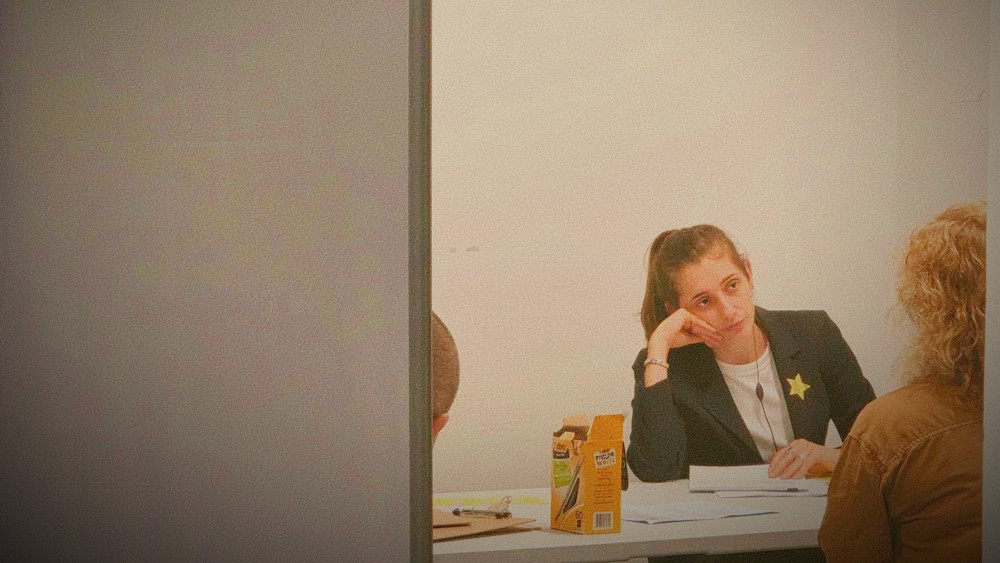Every April, after the dust settles from SXSW, an arts festival emerges from the ashes of the massive extravaganza that burned up Austin, Texas, less than a month before. The 12-year-old Fusebox Festival presents installations, performances, and talks, in a five-day convergence of diverse local and international artists.
Extended Play’s James Carter spoke with artists from four different projects at this year’s festival, which opens today all over Austin.
(All the original interviews have been edited for space.)

Known for their devised theater, the Rude Mechs have received international acclaim for their unique ensemble approach to creating plays. Two of the company’s co-producing artistic directors, Shawn Sides and Lana Lesley, spoke to Extended Play about their newest piece, “Field Guide,” which is using Fusebox as a launchpad for a planned one-month run.
JAMES CARTER: This is the second iteration of “Field Guide.” What’s it all about?
SHAWN SIDES: It started as, ”How to be a good person?” And then that, we found, very broad. So we’ll anchor this with a narrative that we think of as a skeleton. And then we’ll gradually pile more and more onto the skeleton, and the skeleton will be invisible, or even disappear underneath. We picked “The Brothers Karamazov,” and then we continued to get really bogged down in “The Brothers Karamazov.” And the brothers started taking over our lives and our heads and space. Made a lot of demands. And so we’re kind of being held prisoner by “The Brothers Karamazov” right now.
JAMES: (laughing) What’s that like?
SHAWN: (laughing) Well, it can be interesting, but it can also be very frustrating, you know? Some of them aren’t really nice people. It was a weird evolution. And there were times when we were thinking, “Okay we’re just going to completely throw out ‘The Brothers Karamazov.’” And they weren’t having it! They were not having it. They kept coming back.
JAMES: Can you tell me about your process for this show?
SHAWN: The thing is, our process is very different and weird every time. It’s kind of the same. It’s always fun and ridiculously frustrating. But it’s always different, and I don’t have the best memory. So, when we’re smart, we’ll have somebody in the room who’s writing down every single thing that happens and everything we do. And then we’ll have a record of, “Oh! That’s how that happened.” But mostly, we just get in a room and start making things and then completely lose track of, “How did we end up in Russia when we started in Tibet?” I don’t know how that happens, but here we are.
LANA LESLEY: I think a lot of this conversation about how to be a good person sort of was an evolution around our thinking around “Stop Hitting Yourself,” which was a lot about how we present ourselves to the world versus how we actually privately behave. It was generally altruism versus the American bootstrap philosophy. And the actors and company would have to generate an authentic list of the ways in which we are hypocritical when it comes to how we present ourselves in the world. What we want the world to see us as versus what we actually privately really are? I think that was the genesis of the thinking around, “What is actually living a good life? Does it mean that you’re a good person, or does it mean that you just strictly do great things for other people? What is your impact on this world suppose to be as a person?” And we did a draft of it that really did try to consider that. But there wasn’t a way in for every single person in the room, and that’s a really important aspect of our work as a collaborative effort, for everybody to have a way in. And that was the same with “Brothers Karamazov,” and still is. There’s not a way in for everyone into that work either. And so I think that’s why we’re a little a swirl right now in terms of what this play is because these are things we’re all interested in, but we haven’t found the nugget that we really want to drill down into. And there’s still time. I mean, this is still just a draft. But that’s just what we’re picking at right now in this iteration of it.
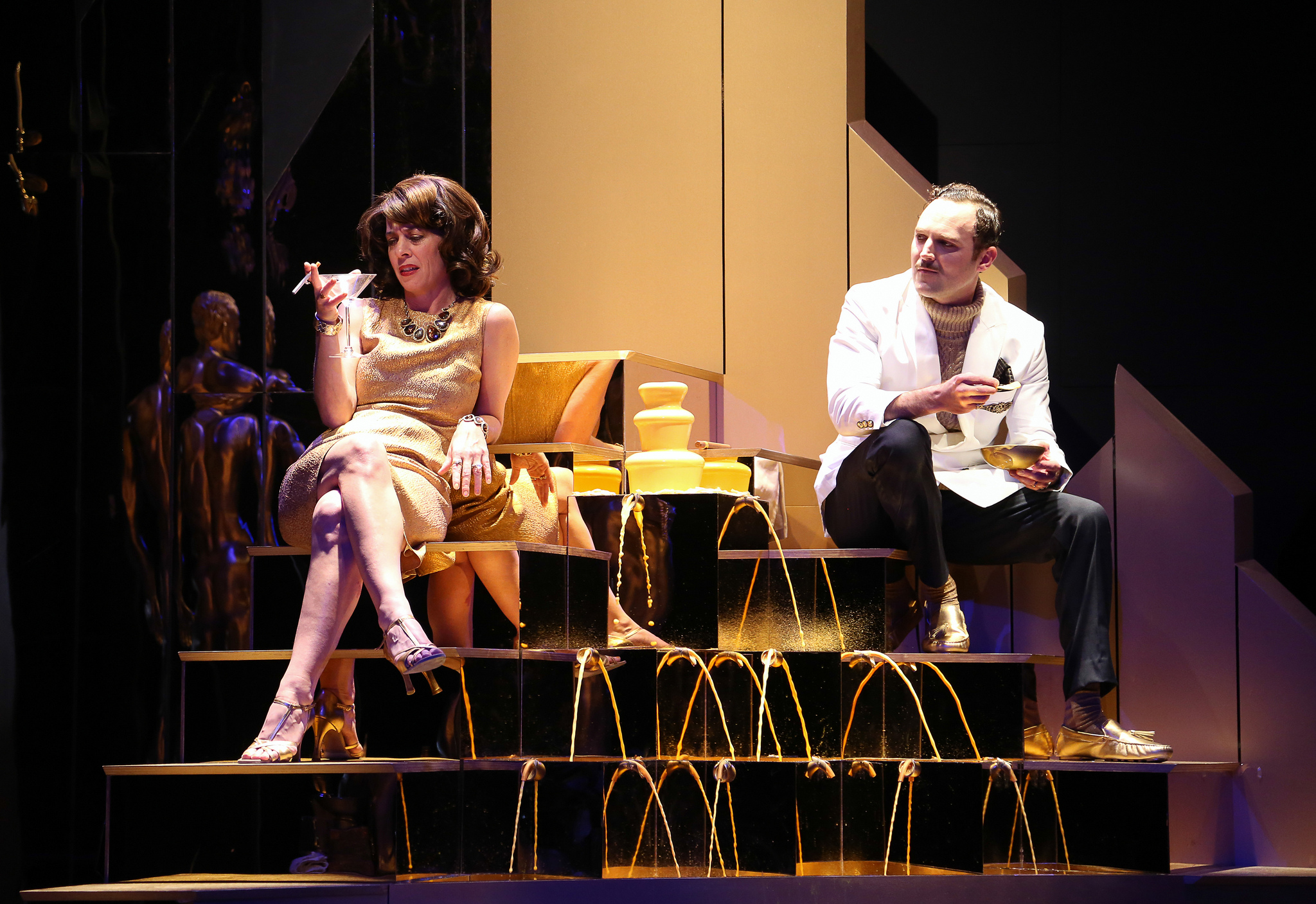
SHAWN: I wanted to throw in because I failed to mention that stand up comedy is also important to us in this play.
LANA: Right. That’s where I was headed. While we were doing the thinking around this iteration, the things we knew we were interested in that had arisen from the first draft was stand up comedy. Hannah Kenah had brought in this really amazing piece in one of the labs we were doing last year, and we knew we wanted to keep that. Kirk Lynn had written this really kind of beautiful rant out of the voice of Dostoevsky that talks about translation and how we translate ourselves or how we get translated by the people around us, but then also it was an adaptation of – we were looking at the film adaptation of the book and the English translation of the book. And the translations had started to really sort of become an important part of the mix even though it’s not actually very obvious. There are layers and layers of translation going on, and that’s something that we’re interested in right now. So those two things are also tugging against all of the other issues that we’re dealing with in the piece.
JAMES: Lana, you were talking about “having a way in.” What does that mean? When you guys are working, does there have to be a consensus?
LANA: Yeah, I think our work is at its finest when every collaborator is in the room, when there’s heat around whatever we’re doing for every single person in the room. You know, it’s just the difference between voting and consensus. It’s like, “Yeah, we won a majority vote of three to five, but the three people who didn’t vote ‘yes’ now have to do the thing, and they’re going to be less engaged and they’re going to be less enthusiastic,” and so that’s really why we try to reach consensus around as much as we possibly can when we’re creating a new work together. So that everybody’s excited and engaged and is bringing something to it, rather than just kind of getting dragged through it.
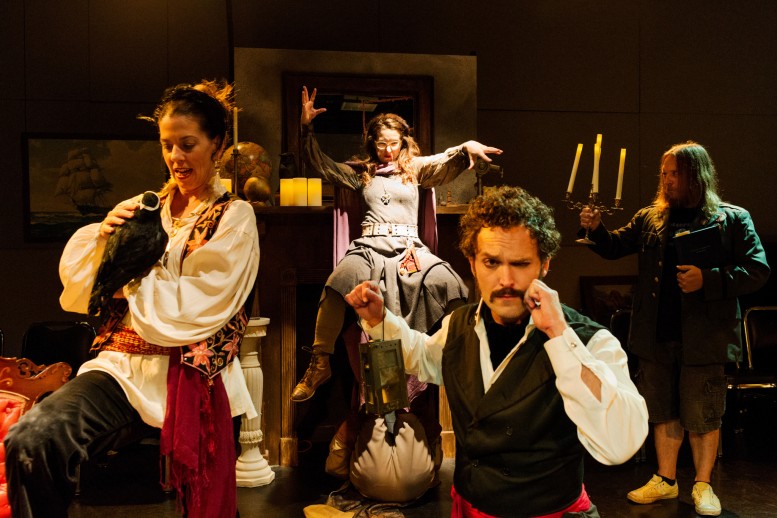
JAMES: This is being billed as a premiere, but it’s always a work in progress, right? Especially if you’re going to do a longer run of it.
LANA: We’re doing a month-long run of this. It’s not the final. This is the second draft of it. So, in our minds, we’re premiering this iteration of it. I don’t know. The word premiere is not very useful in this context, because our plays are constantly changing. We’re constantly going back to them. The only plays we have right now that, when they go on tour, we don’t mess with are “Now Now Oh Now” and “The Method Gun,” because those got so much love and work over the course of so many years. So, yeah. We’re not done.
SHAWN: The thing is, when a playwright is writing a play, it’s a play in development. You know, they’ll write a draft and they’ll have ten thousand readings everywhere. And so it’s the same. It just because we’re devising work, and the physical life of it is absolutely crucial. It’s not just about text on a page. It is important in our process we have to mount a full production in order to get that development stage. And our audience is super cool about it.
“Field Guide” performances:
Thursday, April 7 at 9pm
Friday, April 8 at 8pm
Saturday, April 9 at 2pm
Sunday, April 10 at 4pm
The run continues throughout the month of April, after Fusebox closes.
(90 mins)
DICKIE BEAU UNPLUGGED: DICKIE BEAU
London-based performer Dickie Beau rips audio from old films, speeches and music, remixes them and lip-syncs live and on video. Critics and audiences have lauded his innovative approach to this drag tradition, and in his new production, “Dickie Beau: Unplugged,” he takes a fresh approach, threading his own commentary between several playback performances for which he is known.
JAMES CARTER: You’re known for your playback performances, and this is you “unplugged.”
DICKIE BEAU: Well, yeah this, you having mentioned investigative theater, I mean, just a quick question about you, sorry. But is the term “verbatim” used?
JAMES: Yes, so that’s part of the reason why I wanted to talk to you. Because I feel like the work that you do is in that world, and I’d love to know how you feel about that work.
DICKIE: Yeah, so I think there is a crossover there. And I fell into it. “Unplugged” really is a series of lip-sync performances within the show. But they tell a story of a journey through performance — the relationship between lip-syncing and actually the Greek theater. There’s a way of approaching this modality that is sort of emblematic of the origins of all performance making. And also actually speaks to democracy more widely. So the idea of who can speak for whom, you know, and what is more important, listening or speaking. I think they’re a couple of the questions that come up. And because normally my performances are nearly always mimed and lip-synced to pre-recorded soundtracks… this is different, because I speak. So in that way, I’m unplugged. And there are a few things in the show — it’s hard to describe — that play on that title. In a way, for me, it’s sort of retrospective. In another way, it’s an introduction, just me, to my work.
JAMES: Sure, so those unfamiliar with the work would see something new and sort of get a history of you. And those familiar with your work would see, not a best of, but see some of the favorite hits.
DICKIE: That’s right, it’s a bit like that… And also the show is a little bit shape shifty, so I think about it according to the context that it’s going to be in. But I did it here, and I knew that there was a mixture of people who know me and then people who don’t. And it had exactly that effect, yeah. So the people who knew the work found out the story behind it and where it came from. And people who didn’t know me got to meet me.
JAMES: So the part that you speak, is it all scripted, or is it partially improvised with the audience, or is it both?
DICKIE: Because I have these set pieces that I am going to arrive at, I know where I need to get to. I know sort of what my direction is. But it’s largely extemporized.
JAMES: So there are signposts that you have.
DICKIE: Yeah. There are signposts I have. And then that’s a process in itself, because the thing about lip-syncing — I mean really this is probably true of any performance, but it’s particularly true of lip-syncing — is that you have to be as in the moment as you can be. You don’t want to be leaning too far in the future or dragging your heels. You have to try and surf on top of the sound. And I think it’s true of any performance, you want to be as present as possible. I mean it’s an ideal for life, actually. But of course you’re on train tracks if you’re lip-syncing to a prerecorded track. whereas if you are unscripted, then you have to just be in the moment in a very particular way. So it’s like a personal challenge, in a way. And it’s almost spiritual, I think, at the risk of sounding a bit grand. So in this show, I have to be present, which means, if it was tightly scripted, then one can start to get to a place, and maybe you don’t necessarily look at the faces that are before you, here and now, in the room. So that makes it fun for me.
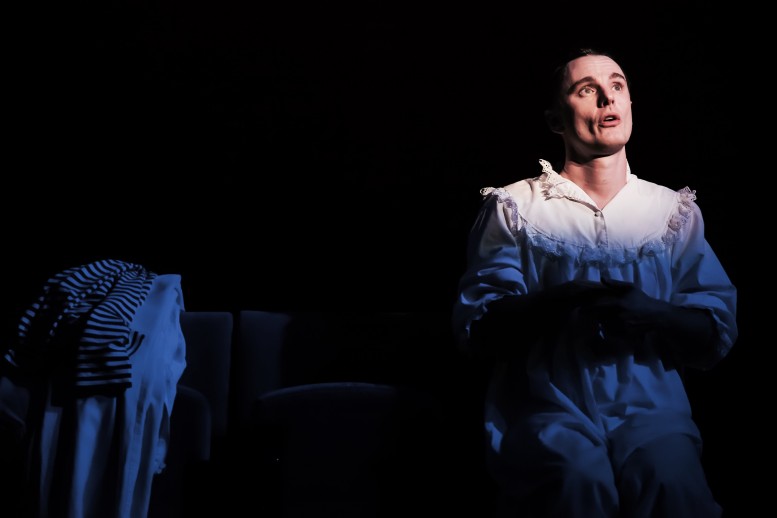
JAMES: Can you talk a little bit about the process of developing this show and how it’s been different that some of your past experiences?
DICKIE: In previous shows, I usually have some kind of conceptual game that I’m playing. And in this case, I think it’s more of a story.
JAMES: There’s a narrative here that hasn’t been in your previous work?
DICKIE: I mean, narrative is inevitable, but I tend to join the dots in a way that’s maybe more intuitive than other ways. But here I could see before me that there was a clear story in which I sort of play a part.
JAMES: Is the story autobiographical?
DICKIE: Yeah it’s autobiographical, but it’s also about something that’s bigger than me. And I think it also implicates the audience. So it’s about that role, of the listener.
JAMES: Interesting. I know you’ve done a lot of video work, as well, and obviously a lot of stage. What’s the difference for you? Do you like one better than the other, or are they just different experiences?
DICKIE: Yeah, well I think that live lip-syncing — that sounds like a contradiction in terms — I think that that’s really where it happens for an audience. That’s more fun for an audience, actually, and it’s scary for the performer. So I think I prefer doing the live. The audience often, because of the quality of the sound — if it’s an old recording — they’ll know that this isn’t coming from your body, but if you’re doing it really well, there’s something uncanny about it. And they forget sometimes, and they go, “Oh my God.” And so it’s a bit like a magic trick. There’s a fun to it. And I also think it does make people, in some cases, listen to the content of what’s being said in a different way, in a fresh way. And I also think sometimes, I talk about this a bit, it’s like vocal mask work. So you do a really good mask performance or clowning, you know, you look through that persona that’s on stage to the heart or the humanity that informs the performance, or the emotion, or whatever’s being expressed, in a way that — and this is partially a taste thing — sometimes a naturalistic performance might not take you as deep. That’s true for me anyway. And I think that is partly a taste thing. So I think that that can happen, depending on the material. On video, the funny thing about video is that, I think some of my videos have been shown in different contexts. And people don’t necessarily know that I’m lip syncing if it’s not mentioned, because we accept that belonging to that medium is the unwritten rule that you can add sound. It’s done all the time in movies. Foley. People take it for granted. We really believe, that this sound is coming from that scene. So we believe that that voice is coming out of that figure. So it belongs to the medium in a way that it means that same thrill, that same excitement of watching somebody lip sync of any kind of virtuosity is not present. And instead, you believe it. And now what that means is you can I think create virtual interventions into the cultural archives. You can misplace voices and replace voices and chop them up. You can fabulate. You can project into the world images so intense that they take on a life of their own, but more readily. And so it is maybe a bit more anarchic, potentially. So yeah, there’s a value to it, I think, in that way.
JAMES: We were talking about verbatim theater earlier. Where do you see your work falling in there? If you’re taking monologues or speeches or bits of dialogue from old films or wherever you’re taking them from, how much are you skewing to the purity of it, and how much are you just, “Hey I want to play with it and remix it to tell the story that I want to tell or say the thing that I want to say?” Does it fluctuate?
DICKIE: I think it fluctuates. I think it depends on the sort of patterns that reveal themselves a bit, you know. I’m sorry that’s a bit vague of an answer, but it does I think depend on the terrain that you’re in, what signposts appear, and how much of an agenda I go in with probably, too. So I think with verbatim theater…anybody who’s giving you an interview is giving you a version of themselves. We’re all performing versions of ourselves to some extent or another all the time. And in a way that’s partly a flag I think I bear. Just don’t forget there’s no essential you, know what I mean? There’s no ground. And that’s scary, but I think it’s also fantastic. Because that means you can be anything. We don’t have to be stuck in the roles that we’re led to believe we need to be stuck in. We don’t have to be. I think it’s a message of hope that we’re empty.
“Dickie Beau: Unplugged” plays Saturday, April 9 at 4pm and 7pm (60 mins)
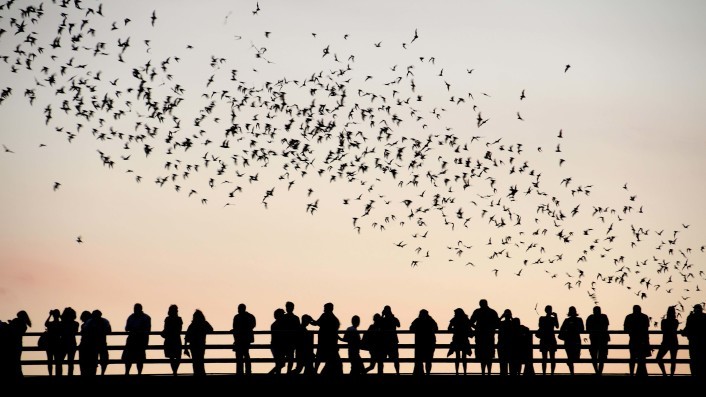
“BAT/MAN” isn’t a sequel to the recently critically decimated “Batman v. Superman.” It’s a finely tuned composition led by Steve Parker that marries the sounds of bat calls, coch shells, garden hoses with funnels, and the human voice. Sound wild? Just wait to see what Steve had to say about it.
JAMES CARTER: For those familiar with Austin and Congress Bridge, it’s well known for the bat population. Can you tell about BAT/MAN and how it came about?
STEVE PARKER: I first was intrigued by the sound component of the bats by actually walking under a bridge where fewer than 1.5 million bats live. That’s Wallard Creek Bridge, which is…around 6th street, kind of. And there’s a smaller creek and a shorter bridge, which is a little bit of an echo chamber, and you can get really close the bats, and I was intrigued by that and just sat there for quite a few minutes when I first encountered it. That was just in the back of my mind that I would be interested in doing something with bats and echolocation.
Then it wasn’t until I was in Germany, a couple years later, when I met, coincidentally, this guy from San Antonio, who is a scientist studying bats, who happened to be in this small town in Germany drinking beer during the World Cup. He told me about his research. We exchanged emails, he sent me some material, and I started messing around with it. I thought there was a lot of potential for sonic and melodic exploration of these echolocation calls. I thought it was really interesting material to explore. I also had been thinking more about the work of Alvin Lucier in the last couple of years. Really intrigued by his work and just this idea of combining those two and then also a participatory element and finding ways to engage with specific spaces sonically for a large number of people with very primitive devices or instruments. So that’s the indirect route I’ve taken to this project. It’s coming together.
JAMES: So the audience uses the echolocation devices that they make themselves. What are the devices made of and how do they work? What’s the process?
STEVE: I actually have a prototype here. [He holds up the device.]
JAMES: Sweet.
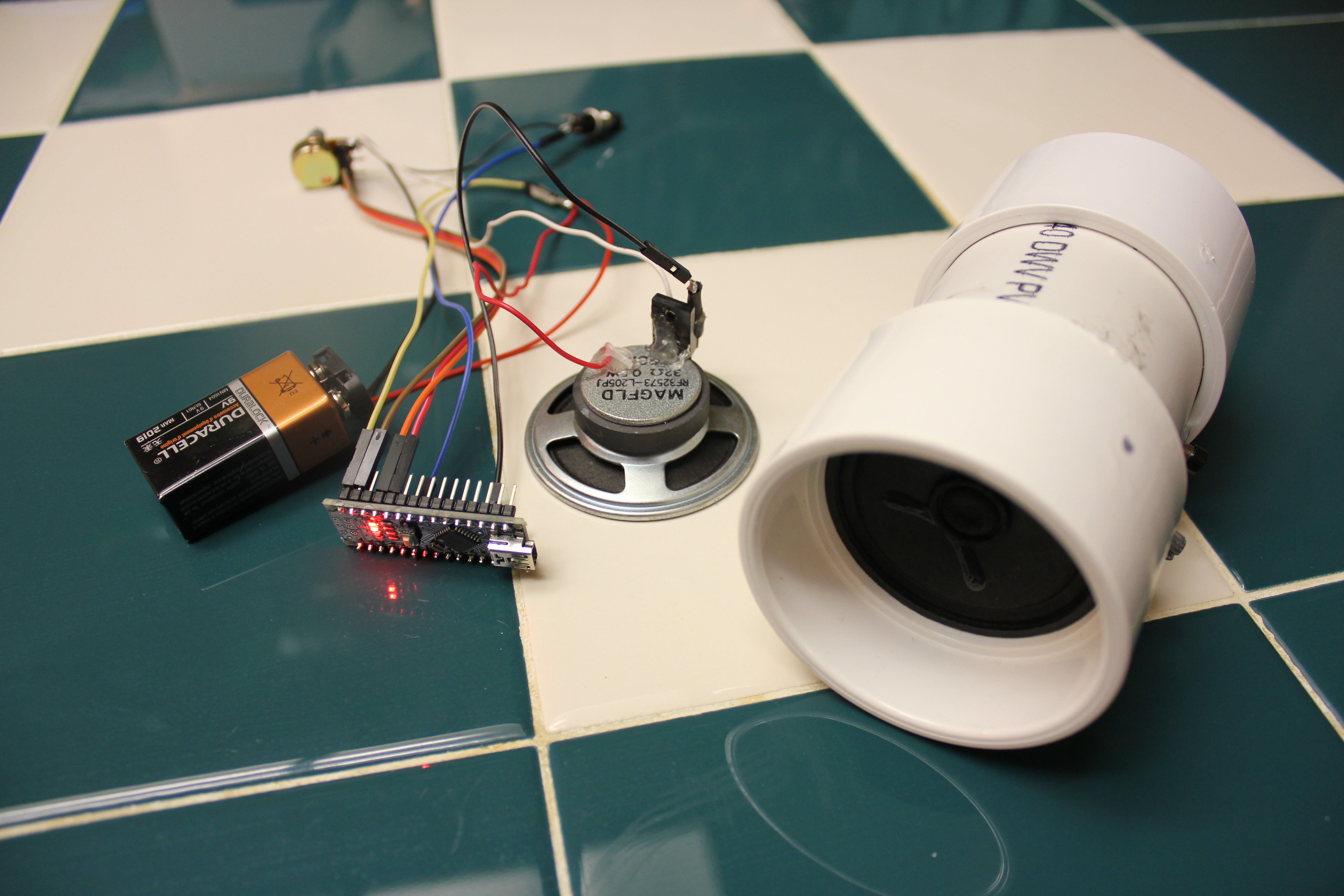
STEVE: It’s very simple. They basically emit a short square wave. It’s funny. I build a lot of things, but I always return to PVC because it’s really cheap and they kind of fit together like Legos. So this prototype was designed by a friend of mine who realized this piece by Alvin Lucier maybe 10 years ago. It’s a piece called “Vespers,” and it’s basically a piece for performers to…it’s a text-based piece that fluxes, in a way. Either you’re supposed to build these echolocation devices, or find something that is a substitute for these. And these are based off of a design from, I think, from the mid-twentieth century. They’re called song bells, and they were designed for visually impaired people to be able to sonically get a feel for what is around and to detect obstacles, essentially. They emit a really short frequency tone. Just a blip. So the frequency tone, the pitch or the note that is being played is constant, but then the frequency, like how fast the tone is happening, is variable. And that depends on how close you are to objects. You change the frequency, itself. This is what it sounds like. [He turns on the device.] It’s a very simple technology.
JAMES: It sounds like a Geiger counter
STEVE: Yeah, yeah. Exactly. It’s just a low blip. And the way you perceive things…the way I experience it, at least, is the overtones above is fundamental. What gives music its color? Like a tone color? The partials that are reflected and resonate in certain areas as they reflect off of different surfaces and materials indicates something about what is in front of you and how far away it is. How big it is. It’s a bit hard to articulate, but if you spend enough time using this thing, you can develop some skill in determining what is around you. It is useful.
JAMES: Wow. Like bats can.
STEVE: Exactly. It simulates how bats use echolocation, but bats also use bat calls to communicate as well. And those are the calls that are a bit more melodic or interesting in a musical sense, you might say. So we’re building these a bit different from this prototype. It’s going to look the same…on the outside, but the guts of it is basically an Arduino chip that we’re programming and fusing together with a few components. These are primarily workshops for high school and middle school students in Austin. Then we’re also going to be doing some workshops for Fusebox participants, where they can also similarly make these echolocation devices. At the concert, we’ll also have other rudimentary echolocation devices that are like clickers. Lucier has a number of surrogates for this device. So that’s sort of the coda of this piece. It’s a homage to this Lucier piece.
JAMES: And will the students and the festival participants attend the concert and participate at the same time?
STEVE: Yes, exactly. So maybe I should just give you an overview of the actual performance works. The performance begins with just live bat calls that are pitch shifted in real time using just a computer and a PA. They’ll be using some resonators, basically things that add melody or harmony to these pitches, or to these sounds. And then creating a series of loops and manipulating them in various ways. Then, concurrently, there will be a choir of conch shell performers who will be slowly, ritually progressing toward this center axis of the performance, making conch shell calls. Just straight calls. And then they converge at this one spot. While they’re doing that, midway through that, there is probably a 100-piece choir — Texas Choral Consort led by Brett Baldwin — they’re going to be coming in with megaphones. I should add, all these instruments are directional, so that when you produce sound with each of these instruments the way you experience the sound is dependent on the space that you’re in. And they bounce off of different structures in unique ways. So these are all going to be directional instruments that are going to be changing the orientation of where they’re pointing. But then the choir converges at a similar spot, and then there’s going to be a feature of the choir. Following that, the conch shell choir, they’re going to be playing these funnel horns. They’re basically made out of garden hoses and these funnels that you use for oil. These are also directional. And you can produce sort of doppler effects with them by swinging them around your head. And they’ll eventually exit in a similar way…out from the center. This is the very melodic, lush part of this piece where there’s actually harmony and melody. I’m going to be using a vocoder. You know, the “talking guitar,” Peter Frampton? That’s a vocoder. So a similar deal you can evolve the sound of the bats with this melody, this vamp. Just a very simple harmonic progression.
BAT // MAN from Steve Parker on Vimeo.
The bats are actually producing the sound indirectly, in a way. When these harmonies are produced, it’s dictated by the actual calls of the bats. Then, at the end of that, that’s going to return to the initial, pure bat sounds and looped bat sounds. That will be accompanied by these echolocation devices that begin with the choir – and also the participants and audience members, things with be distributed to them, and they will participate – and the piece ends with bat echolocation and human-made echolocation. And it’s over.
JAMES: You’re known for using art as a community-building tool. Why is this type of work important to you, and what do you hope will happen with BAT/MAN?
STEVE: For me, it’s an important part of just they way I work because it helps me figure out what I’m doing and find relevance in what I’m doing. I find a lot of things interesting, but I don’t necessarily think they’re interesting to everyone. I also think it’s a good way to help people perceive things that they don’t normally perceive. It’s a good point of entry. In my work, I’m really interested in finding cooperative ways to produce meaningful performance. I think there’s something really exciting and there’s a certain energy in performance that I experience when I do these sorts of cooperative performances versus that with highly trained classical musicians, or whoever you’re working with. I feel like there’s an energy to the performance that I find very moving and effective when I’m working with a group of people who maybe don’t normally associate themselves with being trained performers but then they discover this latent expressiveness in what they’re able to do. And also this sense of discovery of making something beautiful from something really primitive. And, by that, I don’t mean the people are primitive. I mean, the actual tools we use are very primitive because I think there’s a fair amount of unpredictability with primitive material like this, or like a conch shell, or a didgeridoo, or an instrument made out of a garden hose. I think there’s something really beautiful about using these types of objects in a large group and seeing what beauty emerges from that.
“BAT/MAN” performs Sunday, April 10 at 7pm (50 mins)
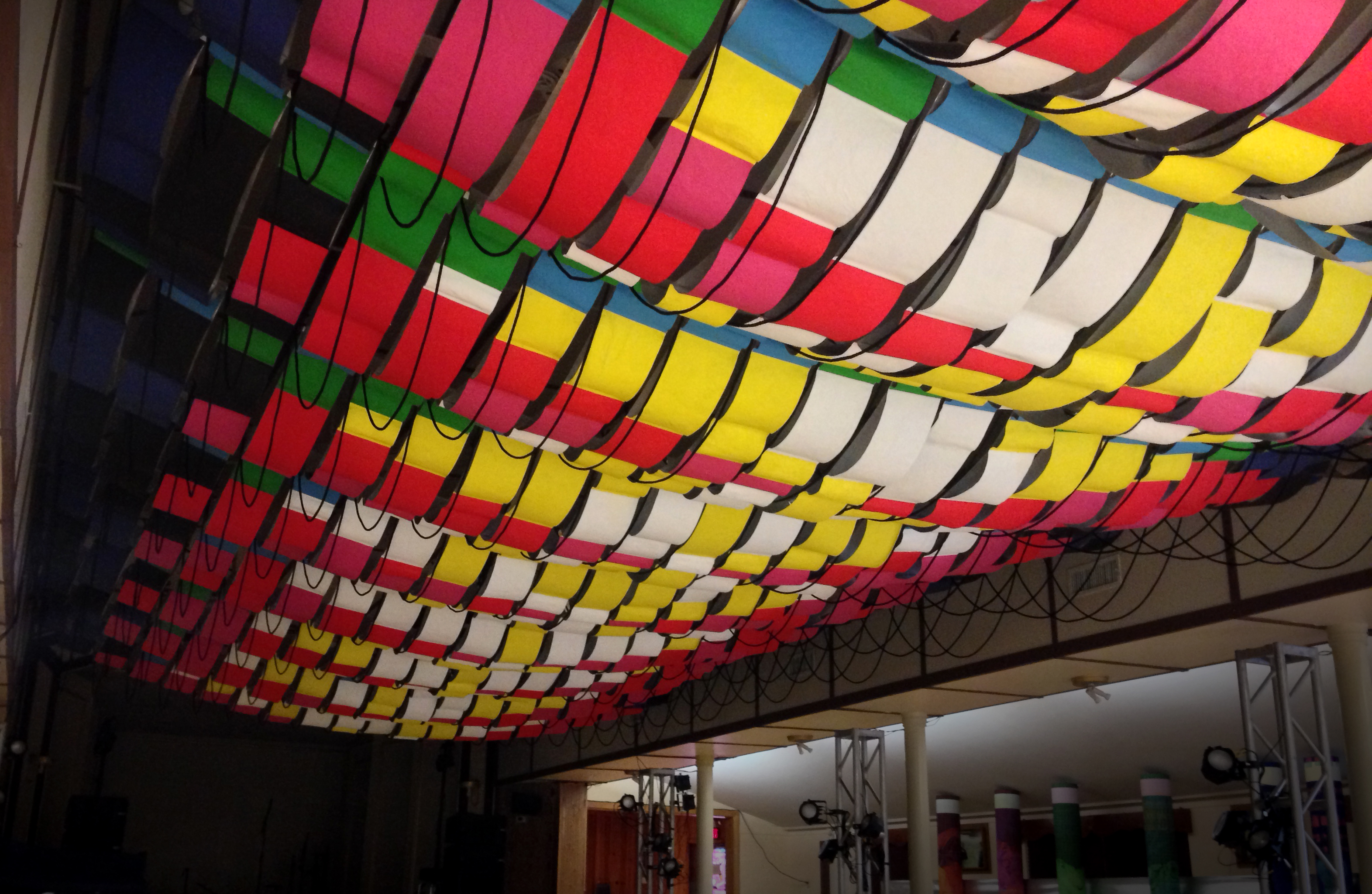
JAMES CARTER: Tell me about the RGB Hub. How did it come about, and what was the development process?
IGOR SIDDIQUI: RGB Hub is a site-specific installation that we designed for the Fusebox Festival, and it really has a double role — on the one hand, it provides the kind of — it literally provides a social hub for the festival, meaning that it accommodates many of the festival’s programs. It’s also set up as a bar, a place where festivalgoers can convene and share their experiences with one another. So there is the kind of the social and the functional aspects of it, and then it’s also an artist project that really looks at how through the use of color, lighting and graphics, we could kind of transform the existing spaces of the hub into kind of an atmosphere that’s specifically tailored to the festival, and could be experienced as an installation, as an artist’s project.
JAMES: Is this the first year that they’re transforming the sort of social space of the festival, or is it the first year that there is a social space for the festival?
IGOR: So, Fusebox has always had a social hub. The programming takes place all over the city at a range of venues, but there has always been a social hub, which is a late night place for the festivalgoers to come together. What’s a little bit different about it this year is the space itself that we’re using. So we’re taking over Saengerrunde Hall, which is a traditional German social club in downtown Austin, and it includes a dance hall, a bowling alley and it’s adjacent to a beer garden. So the space itself has a lot of character already, and so what we were tasked with was really kind of creating almost like a virtual environment that would be very special, and yet ephemeral because it would be up for five days during the festival.
JAMES: That’s exciting.
IGOR: Yeah, it’s super exciting. And I think it’s very interesting to, on the one hand, combine kind of the functional aspects of a social hub with an opportunity to create a very special environment in terms of experience.
JAMES: So what do you imagine the spaces will look like once you have installed?
IGOR: RGB Hub, the title comes from Red, Green and Blue.
JAMES: Right.
IGOR: And of course, the Fusebox Festival having such a kind of a strong foundation in performing arts, it made sense that we would take something really essential, like red, green and blue lighting, and kind of use it as a vehicle for transforming the space. And so, at a very basic level, what RGB does is it takes this very simple phenomenon, which is that under certain circumstances, the red, green and blue lights create CMYK shadows — so, cyan, magenta and yellow shadows — and then also, in terms of graphics, those lights have the ability to filter out some of the colors, so it’s really a play on dealing with kind of the RGB-CMYK dynamic, between kind of additive color and subtractive color. So the first thing that we did was we reoriented the existing architecture of the hall by having all these visitors enter through a side alley, which kind of changes the venue from a German social, or from a German dance hall to something that’s a little bit more club-like. Then at the core of the design scheme is an enormous ceiling installation in the main hall, which is about 20 feet by 70 feet, that’s really about creating this kind of virtual architectural layer within the space, using this kind of RGB-CMYK phenomenon. It’s really about the combination of kind of graphic color and colored lighting.
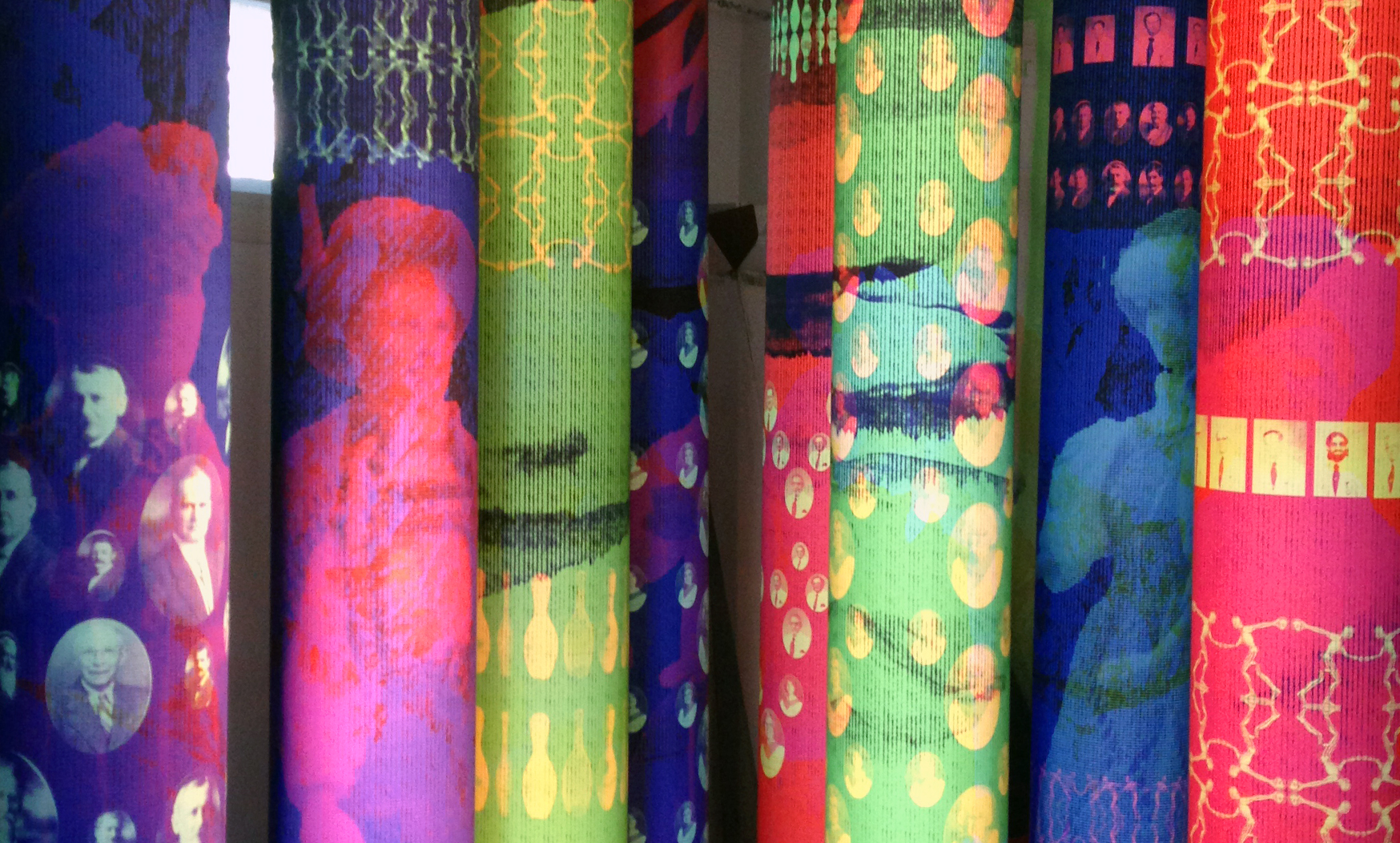
And we’re also, then another layer is creating — another kind of virtual layer is creating a series of columns that use CMYK graphics in combination with lights that kind of take on, or that take existing motifs, images and patterns from the existing space, so there are Bavarian Barbies that exist in these little dioramas of the hall, there are amazing vintage photographs from the society’s bowling league, and really kind of amplifying those so that they become this kind of contextual but also transformed feature. So really the idea for the space is that it would be kind of strangely familiar and also radically transformed at the same time.
JAMES: Are you using lights and projections? What are you using to transform the space?
IGOR: So there are three things: one is colored lighting, two is material, which is colored, which light is then projected onto, and then three is graphics. So it goes from kind of lighting, which we think of as theatrical, to the kind of colored material, which we think of as architecture, and then kind of the printed graphic, which we think of as graphics. So it’s kind of taking lighting, architecture and graphics and fusing them together to make this experience.
JAMES: You’re using student researchers. How are they working with the project?
IGOR: This project is realized as a collaboration between myself, as the principle designer for the project, and the University of Texas at Austin Materials Lab. The Materials Lab is a resource center at the university and also within our community to advance materials research and materials innovation. I am working with two undergraduate research assistants who have been on board since the beginning of the project, and they have been my design assistants, and then the Materials Lab there has a team of student researchers that have looked at everything from material properties to lighting behavior and collaboratively there are about eleven people on our team that is responsible for fabricating and installing all aspects of the installation.
JAMES: It seems your work focuses quite a bit on geometry and color. Can you just talk to, a little bit, about what excites you about that? And maybe about what transforming spaces?
IGOR: Absolutely. My body of work through isssstudio, which is my practice, as well as through my research through the university as Associate Professor at the School of Architecture, has really looked at different ways in which architectural surfaces, sometimes they’re outside, you know so sometimes they are surfaces that are building exteriors, sometimes they are immersive interiors, but the ways in which surfaces can really be animated under the influence of digital technology, meaning that we can produce new kinds of patterns, new kinds of material behavior and new kinds of experiences. And so geometry always plays a big role in it, because it’s the thing that kind of allows you to connect digital means of designing and then the actual material output. As you will see in the ceiling piece for RGB Hub, the pattern is really about organizing color and organizing geometry, but also it’s a vehicle for staging a set of optical and perceptual experiences. And so, yeah, I think geometry always plays a big role in the work because it allows us to create something that can be quite intricate in terms of experience, but also something that can be entirely measurable ends up kind of transcribed from design to realization.
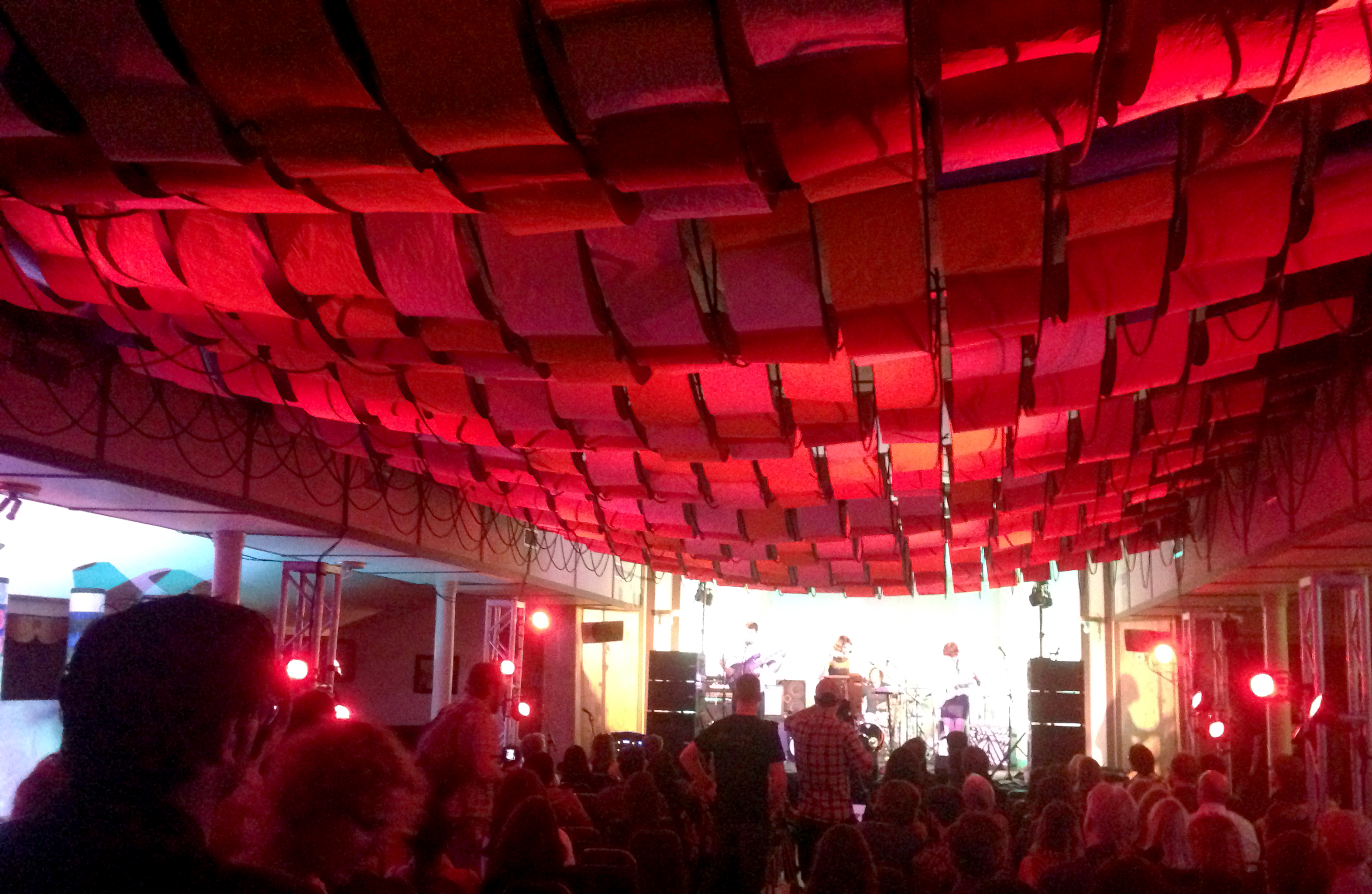
JAMES: How do you hope the festivalgoers will react to the installation?
IGOR: Well, my hope is that we’ll create a kind of atmosphere that the visitors will be able to kind of plunge into and surrender to. A kind of atmosphere that might seem mildly, at least, intoxicating, that might transform their expectations and that might bring them temporarily to this other perceptually rich world.
RGB Hub opens Wednesday, April 6 and runs throughout the festival, closing April 10. From 8pm daily.
Author
-

James Carter is a writer and experience designer. He was a founding member of terraNOVA Collective and its associate artistic director for eight years. Recent transmedia plays include "FEEDER: A Love Story" (terraNOVA/HERE, NYC) and "NY_Hearts" (One Muse Presents & The Brick Game Play Festival). James also works as a social impact strategy and research consultant for Lina Srivastava, LLC. He has written for the Creators Project, Culturadar.com, ArtsFwd and Theatre Communications Group.
View all posts


